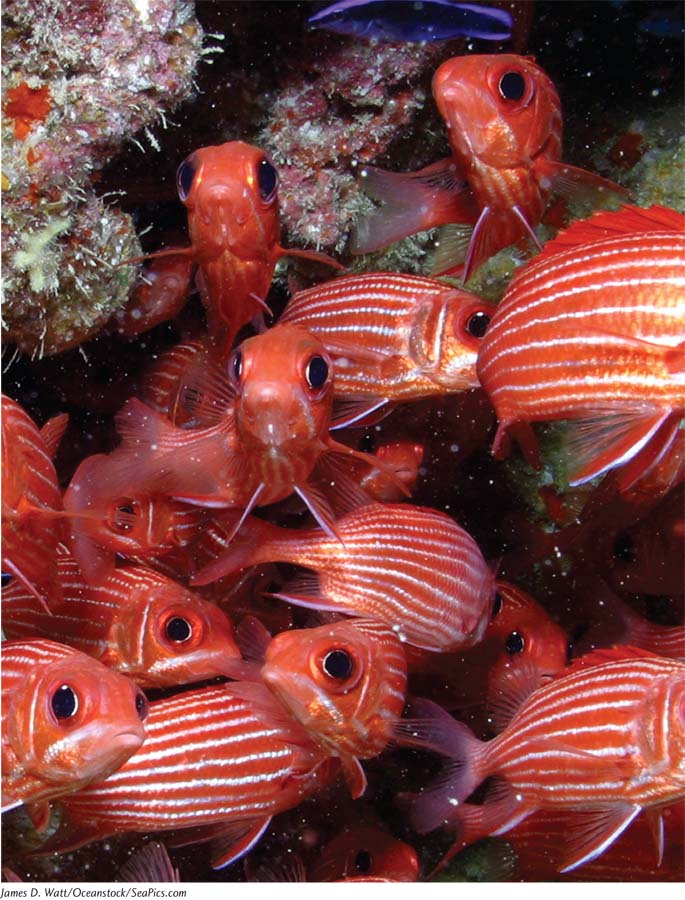Chapter Introduction
chapter 18
Conservation of Biodiversity

Modern Conservation Legacies
The biodiversity of the world is currently declining at such a rapid rate that many scientists have declared that we are in the midst of a sixth mass extinction. There are many causes of this decline, but all are related to human activities ranging from habitat destruction to overharvesting plant and animal populations. In response to this crisis, there is growing interest in conserving biodiversity by setting aside areas that are protected from many human activities.
Efforts to protect marine habitats are relatively recent.
The conservation of biodiversity has a long history. The United States, for example, has been protecting habitats as national parks, national monuments, national forests, and wilderness areas for more than a century. Yellowstone National Park was the first national park in the United States, designated in 1872 by President Ulysses Grant. During the presidency of Theodore Roosevelt (1901–
In contrast to the long history of protecting terrestrial habitats, efforts to protect marine habitats are relatively recent. One of the most expansive efforts in the United States was made during the administration of George W. Bush. From 2006 to 2009, President Bush designated a total of 95 million hectares (215 million acres) of marine habitats as protected around the northwestern Hawaiian Islands and other U.S. Pacific islands. In the northwestern Hawaiian Islands, 36 million hectares (90 million acres) of these marine habitats were set aside as the Papahānaumokuākea Marine National Monument. This protected region is immense, covering an area about the size of California.
The marine ecosystem that surrounds the Hawaiian Islands contains a great deal of biodiversity—
The Papahānaumokuākea monument presents an opportunity for improving the Hawaiian marine environment. As a national monument, the area is protected from fishing, harvesting of coral, and the extraction of fossil fuels. Large amounts of solid waste debris are being removed from the shorelines and coral reefs, and efforts are under way to clean out much of the invasive algae. It is expected that the biodiversity of the area will quickly respond to these efforts. As the populations of organisms increase in the protected areas, individuals will disperse and add to the populations in the larger surrounding area. In this way, the protected area can serve as a constant supply of individuals to help neighboring areas maintain their diversity of species.
In the United States and the rest of the world, conserving the biodiversity of marine areas by creating marine reserves is a relatively new activity for governments, but the idea is gaining ground. In the Galápagos Islands, where Charles Darwin studied the evolution of finches, the nation of Ecuador recently designated a marine reserve that extends 64 km (40 miles) into the ocean from the islands and allows only limited fishing. Marine reserves have also been designated by Russia, the United Kingdom, Australia, Canada, and Belize.
Efforts to protect critical wildlife habitats continue today. For example, in 2009 the Obama administration set aside more than 484,000 km2 (187,000 square miles) of Alaska coastline and waters as critical habitat for polar bears. Although this does not prevent activities such as gas and oil drilling, it does mean that potential impacts on polar bears must now be considered when such activities are proposed in this area. As more countries develop marine reserves, we have to make sure these areas are large enough to allow long-
Sources: P. Thomas, President Bush to add marine reserves; not all are applauding, Los Angeles Times, January 6, 2009. http:/
Preserving habitats is one important way to protect against declines in the world’s biodiversity. In this chapter, we will examine declines in biodiversity at multiple levels including declines in the genetic diversity of wild plants and animals, declines in the genetic diversity of domesticated plants and animals, and declines in the species of large taxonomic groups. We will also investigate the major causes of these declines, which include habitat loss, overharvesting, and the introduction of species from other regions of the world. To help curb the loss of biodiversity, we have a number of laws and international agreements that are in effect. Approaching these efforts with an understanding of the concepts of metapopulations, island biogeography, and biosphere reserves can help us succeed in protecting large ecosystems.